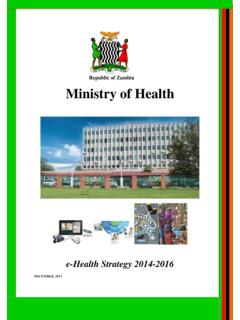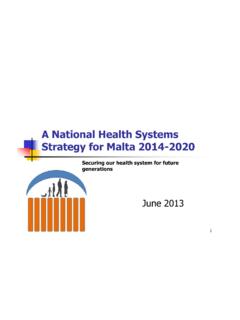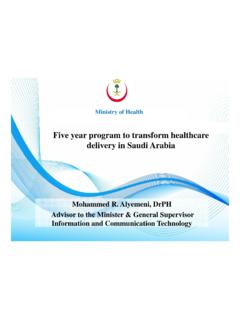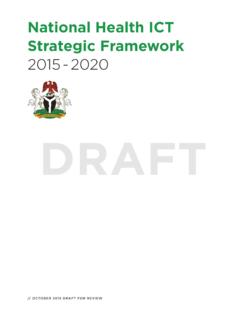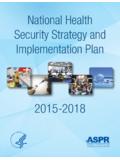Transcription of Kenya National e-Health Strategy - Universal Health 2030
1 Kenya National e- Health Strategy 2011- 2017 Ministry of Medical Services Ministry of Public Health and SanitationAPRIL 2011 Republic of KenyaInvestment Climate Advisory ServiceWorld Bank GroupMultilateral Investment Guarantee AgencyInternationalFinanceCorporationWor ld Bank GroupThe World Bank1 Kenya National ehealth StrategyFOREWORD 3 PREFACE 5 ACKNOWLEDGEMENTS 7 EXECUTIVE SUMMARY 91. THE CASE FOR A National e- Health Strategy 11 Context 11 Background 16 What is e- Health ? 172. STRATEGIC FRAMEWORK 18 Vision 18 Mission 18 General Objectives 18 Specific Objectives 18 Strategic Areas of Intervention: The five pillars 19 Principles 193.
2 GOVERNANCE 21 Structure 21 Legal Issues 22 Regulatory Issues 224. IMPLEMENTATION 24 Framework 24 Timeline 255. MONITORING AND EVALUATION 27 High Level Monitoring and Evaluation Framework 27 APPENDIX A: POLICY FRAMEWORK 28 APPENDIX B: National E- Health Implementation Worskhop Report Executive Summary 34 APPENDIX C: Proposal for using e- Health to improve healthcare delivery 38 APPENDIX D: List of E- Health Strategy Contributors 43 APPENDIX E: List of Stakeholders at Feb 2011 Workshop 44 Table of Contents2 Ministry of Medical Services and Ministry of Public Health and Sanitation 3 Kenya National ehealth StrategyForeword The development of the E- Health Strategy comes at an important time when the Health sector is implementing far reaching reforms to achieve Universal coverage.
3 The E- Health Strategy is anchored on the achievement of Vision 2030, whose overall goal in Health is to have an equitable and affordable healthcare at the highest achievable standard to her citizens. It is informed by the strategies and results emanating from the implementation of the Kenya Health Policy Framework, 1994-2010, the Health sector strategic plans and the e-Government and Shared Services Strategies implemented through the e-Government Directorate and the ICT Board implementation of the e- Health Strategy will accelerate the ongoing reforms that are geared towards consolidating and strengthening the gains witnessed in the sector since 2003, when a reversal of Health indicators started to be seen.
4 The Strategy will also address some of the key challenges experienced during the implementation of the Kenya Health Policy Framework, 1994-2010 and the Health sector strategic plans, that include disparities in access between the urban and rural areas and especially the hard to reach areas; the inadequacies of the Health infrastructure across the country; the shortages of the human resources for Health ; the high cost of accessing Health for majority of the Kenyans and the limitations in the availability of financial resources. It will accelerate the decentralisation of quality Health services to rural areas, a factor that will also be reinforced through the implementation of the New Constitution and devolution.
5 The e- Health Strategy will also facilitate the strengthening of partnerships on the provision of quality healthcare and specialised services. It will not only promote partnerships with the private sector, but will also enable the sector tap into the skills and knowledge on healthcare that exist in the more established institutions both within and outside the country. Towards this end, Kenya will be able to build capacity among its key Health personnel through technology transfer and training at minimal cost. The wide use of e- Health will open new opportunities for multi-skilling, business and e- Health Strategy will make use of the already available National ICT infrastructure; conducive policy and legal environment and local expertise to harness ICT for improved healthcare delivery in addition to other ongoing efforts.
6 Efforts will also be made to fundamentally change the way information is accessed and shared across the Health system. The implementation of the e- Health Strategy is expected to transform operations in the sector and facilitate the country into becoming a hub for accessing specialized Health services and achieve Universal coverage by 2030. In order to have a Strategy that is holistic and inclusive, the development of the Strategy used a participatory process. First, the consultative process included taking into account results from the 1st Ministerial meeting on e- Health in East, Central and Southern Africa held in Mahe in October 2008.
7 The meeting brought together key stakeholders from the region to share their experiences in the implementation of e- Health interventions and discuss and agree on a plan of action. This meeting was the first country-level stakeholders consultative meeting in November 2008. It included representatives from Government Ministries and Departments, Universities, private sector players including those from hospitals, civil society organizations and development partners. This meeting was followed by other consultative meetings at both technical and policy 4 Ministry of Medical Services and Ministry of Public Health and Sanitation level.
8 A draft Strategy was shared in July 2009. The process benefitted greatly from expert input that took into account information from other sectors and countries. Using the draft shared in 2009, a second version of the Strategy was, following stakeholder review, drafted in May 2010. In late 2010, MOH and the World Bank Group through its Health in Africa Initiative (HiA) and Kenya Investment Climate Program partnered to prioritize the strategic interventions and develop an implementation framework. This partnership resulted in a stakeholder workshop in Naivasha in February 2011; the stakeholders in the workshops prioritized the Health information systems pillar, divided it into five functional domains and adopted the notion of enterprise architecture as implementation framework for the Strategy .
9 Hon. (Prof.) P. Anyang Nyongo, EGH,MP Hon. Beth Mugo, EGH, MPMinister for Medical Services Minister for Public Health and Sanitation5 Kenya National ehealth StrategyPrefaceThe National e- Health Strategy presents a set of interventions that the Health sector plans to use to facilitate the efficient and effective delivery of services. It reviews how the sector has performed over time in terms of the policies, strategies and plans that have been in use. It identifies the strengths and opportunities that exist and which can be leveraged to fast-track e- Health .
10 With the National ICT policy and e-Government Strategy already in force, it is recognized that critical success factors in the implementation of the Strategy will include political will; the availability of skilled manpower and high standard Health institutions as well as the availability of ICT infrastructure. Challenges to the effective implementation of e- Health include the lack of an e- Health Policy; inadequate infrastructure and equipment; insufficient human resources and skills as well as low funding to the sector; low awareness; insufficient/unreliable power supply as well as inadequate legislation.



